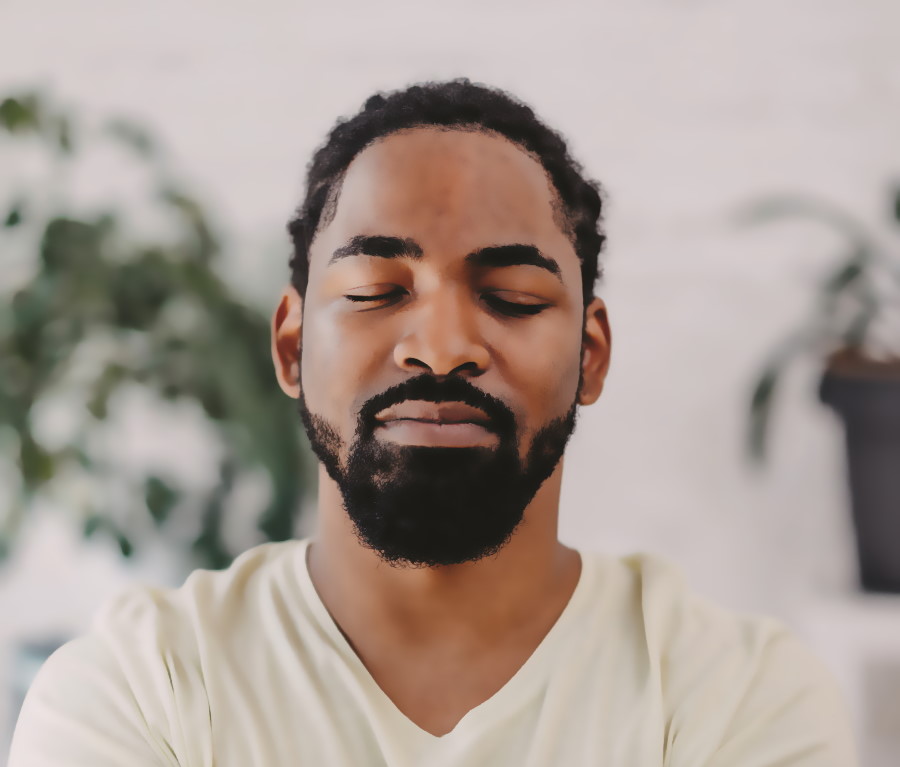Meditation and Adult ADHD
Attention Magazine August 2022
How Meditation Can Help Improve Your Life Skills and Happiness
Perhaps you have heard of meditation and its benefits. Perhaps you have heard that meditation can be one of the most helpful activities that a person with ADHD can do for improved life outcomes.
You may say, “Sounds good. How can I get started?” If so, then please read on.
Concentration meditation to develop focus
 One great starting place for a meditation practice is to choose a technique that emphasizes developing concentration. When doing such methods, we first pick something to focus our attention on and then do our best to experience the full, vivid texture of it. We will, however, probably soon notice that our mind has wandered away into thinking and other distractions. The instruction then is to choose to patiently shepherd awareness back to the chosen object of focus. If, after a bit, we notice that we have gotten distracted again, we patiently return again. Time after time, again and again, we notice how our mind has drifted from our chosen object of meditation, and we gently bring it back.
One great starting place for a meditation practice is to choose a technique that emphasizes developing concentration. When doing such methods, we first pick something to focus our attention on and then do our best to experience the full, vivid texture of it. We will, however, probably soon notice that our mind has wandered away into thinking and other distractions. The instruction then is to choose to patiently shepherd awareness back to the chosen object of focus. If, after a bit, we notice that we have gotten distracted again, we patiently return again. Time after time, again and again, we notice how our mind has drifted from our chosen object of meditation, and we gently bring it back.
This repeated returning of awareness can be simple, repetitive, and at times boring work, like lifting a weight or practicing piano scales. However, it develops our power of concentration, our ability to intend to pay attention to something and have attention actually stay there. This is a capability that many people usually consider to be just a matter of chance or luck, but is actually something that we can improve. And, thankfully, the more we work at it, the easier it becomes.
A classic first meditation practice is to develop concentration by focusing our mind on our breathing, often as we feel it in our nostrils or in the pit of our belly. Another classic focus choice is to unify our full attention in the soles of our feet while walking.
A settled, unified, and concentrated mind is an important and useful building block for doing most other meditation techniques. Developing concentration also helps build our ability to stay focused on just what is right in front of us, and to do one thing at a time and engage in it fully. This can be helpful, for example, when doing manual work like cleaning the house, to not get bored and quit to go check social media, but instead to stay engaged until the task is done.
Cultivating concentration helps us to get into the habit of regularly asking ourselves: “Am I paying attention right now to what I want to be paying attention to?” Such a practice can help us to break out of unconscious negative hyperfocus ruts in our daily life, when, for example, we might get spaced out by checking out on the internet. The effort of working to focus our minds also generates energy, vitality, and motivation, which can uplift us during times that would otherwise be stuck in low-dopamine, lethargic, low motivation.
Deeply feeling body sensations
Another technique that is ideal for those of us with ADHD is to ground our attention into how our body feels. One way to do this is to bring our attention to a sensation and hold our full attention there for a couple seconds, and deeply, richly, and fully feel that sensation, accepting and making space for it exactly the way that it is. We then release the hold, and our attention may want to stay in the same spot, or it may wander to a different one. We then repeat the process over time, in a patiently rhythmic manner.
Fully and richly feeling body sensations is a great technique to do when feeling agitated, restless, antsy, spinning, impatient, and/or socially anxious. It can transmute those kinds of suffering into a sense of self-soothing, groundedness, settledness, and openness. And deeply, vividly experiencing how the body feels at each moment can help us to feel more satisfied and nourished by even the otherwise boring mundane moments of our day.
Repeating a phrase for positive affirmation
Another useful beginner technique is to mentally repeat a positive phrase or word. This is sometimes known as doing “affirmations” or a “mantra.” When performing this method, as best we can, we ground our full attention in the repetition of the phrase and in feeling its meaning flow through our body.
The phrase that we choose for such a practice does not have to be anything mystical-schmystical. It can embody anything you’d like to work on, cultivate, or emphasize in your life: for example, you could repeat “I am comfortable living with sobriety” or “I am learning to feel the impact of my words on other people as I speak.” Or, it can be a single word, like “calm” or “relax.”
My favorite repeated phrase is “May I be happy and healthy, and may I be patient, friendly, and forgiving with myself.” After moments of self-criticism, repeating this phrase helps me to soften, open my heart, and drop back into a positive and empowered state.
Repeating a phrase is also a technique that emphasizes developing concentration, as repeatedly bringing our wandering minds back to our chosen words has the benefits described above.
How meditation is similar to physical exercise
If you are new to meditation, it may help to understand it by the ways that it is similar to physically working out.
- Both can provide all sorts of positive mental and physical health benefits. But, to gain these blessings, we need to invest the time and effort into actually doing them.
- Both sometimes produce dramatic, immediate, and easily perceivable positive changes. Most of the positive changes, however, are small, incremental, and almost imperceptible.
- There is no one single technique that is appropriate for all people at all times; selecting a method depends on individual goals and circumstances.
- When developing a new practice, it works best to start with bite-sized, doable goals and expectations, and work up from there.
- Both can sometimes feel uncomfortable, tiring, frustrating, painful, and challenging, and they can sometimes feel relatively effortless, pleasant, and blissful. However it feels, though, we are making progress as long as we are putting in the time.
- With both, the aim of our dedicated exercise or meditation practice is not just the experience we have when doing it, but the positive impact that it has during the rest of our life. And, in both cases, being active or mindful in our daily life has a great reciprocally supportive relationship with our dedicated formal practice.
In sum, meditation is something that we can all do and get benefit from. If you are interested in knowing more about my work, including my weekly sitting practice group, please feel free to visit intromeditation.com.

How to get started
Here are ten steps to help you start a meditation practice.
- Try to find a time of day to meditate that works best for you. Some common times are first thing in the morning, last thing at night, right after the workday, or, when needed, whenever you are able to fit it in.
- Pick a place in your house that is calm and out of the way, and minimize distractions. Let people know that you will be unavailable for a bit.
- Try to sit in a way that will feel comfortable and pain-free for as long as you meditate. If you can sit cross-legged on a cushion, great, but sitting upright in a chair can be just as effective. It’s usually best not to lie down, as this can lead to more easily falling asleep. And although it’s more settling and calming to sit, meditation while walking can also be useful when feeling especially sleepy or agitated.
- You may want to do a little ritual, like making a bow or saying a phrase that feels meaningful to you, at the beginning and end of your meditation, so as to create a container of transformation.
- Start small—even one minute. You can work up from there, starting to progressively stretch meditation periods just a little bit longer than feels comfortable.
- It can be helpful to explore different techniques, postures, settings, and times of day, and see what works for you.
- Especially as a beginner, playing a guided meditation from a phone app or website can provide useful guidance and structure. I recommend the Brightmind app, and Insight Timer, Headspace, and Calm are popular choices as well.
- It can at times be supportive and motivating to find a buddy to meditate with, or even an online or live meditation group.
- In addition to dedicated periods of “formal practice,” it can be grounding and openness-creating to take micro-breaks during the day to check in with our present-moment experience of our body and breath. This is especially helpful when working on a computer or doing something else mental.
- If we find ourselves suffering during meditation or even resisting doing it at all, we may ask ourselves, why might it feel uncomfortable today to simply sit with and face who we really are? One answer may be to make external changes that we have been putting off—such as to clean off our desks or return a difficult phone call before we meditate. Another option would be to make some internal changes, like to give ourselves permission to be imperfect in our meditation, and bring more self-friendliness, self-patience, and self-forgiveness to it.


 Adam Coutts has meditated daily since 1989. For four years he lived in Buddhist monasteries in America, India, Thailand, and Japan. He began teaching people how to find center, grow in vitality, and feel a greater depth to life through meditation in 2002. He has taught through weekly sitting groups, one-on-one coaching, eight-week classes, live and virtual classes in corporations, jails, and schools, as well as writing. Visit his website at
Adam Coutts has meditated daily since 1989. For four years he lived in Buddhist monasteries in America, India, Thailand, and Japan. He began teaching people how to find center, grow in vitality, and feel a greater depth to life through meditation in 2002. He has taught through weekly sitting groups, one-on-one coaching, eight-week classes, live and virtual classes in corporations, jails, and schools, as well as writing. Visit his website at 